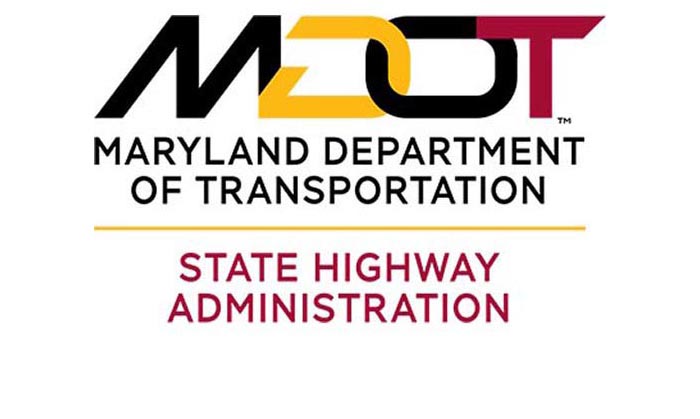
MDOT SHA Logo
Governor Martin O’Malley Declares April Work Zone Safety Awareness Month; Officials Promote Work Zone Safety in Active Work Zone
(April 14, 2010) – Within the active work zone at the massive Charles Street and Baltimore Beltway project site, Maryland Department of Transportation (MDOT) Deputy Secretary Harold M. Bartlett joined State officials to champion the cause of work zone safety and present Governor Martin O’Malley’s Proclamation declaring April as Work Zone Safety Awareness Month. Maryland’s efforts coincide with National Work Zone Awareness Week (NWZAW), which will be kicked off next Monday in New York. Organized by the Federal Highway Administration, American Association of State Highway and Transportation Officials American Traffic Safety Services Association, Washington, D.C., Virginia and Maryland, the NWZAW observation raises awareness about work zone crashes in an effort to save lives, reduce injuries and recognize the heroes who work daily to improve roadway conditions and safety.

“The O’Malley/ Brown Administration is committed to the safety of Marylanders,” said Deputy Transportation Secretary Harold M. Bartlett. “Everyone - workers and drivers alike - are threatened by speeding and inattentive drivers, particularly in construction work zones where there is little margin for error. With the construction season getting underway, we urge drivers moving through work zones to slow down, be alert and be patient. Your life, and the lives of others, depends on it.”
This construction season includes the deployment of the SafeZones technology, which currently rotates within three work zones, including the interchange project along the Baltimore Beltway at Charles Street. The goal of the program is to modify driver behavior and make work zones safer for workers, drivers and their passengers. Since the program’s start last October, 8,000 warnings and 18,700 citations have been issued. The law that allows automated speed enforcement was passed during the 2009 legislative session and became effective on October 1. Transportation Article §21–810 allows law enforcement to use speed cameras to fine drivers exceeding the speed limit by 12 or more miles in work zones along controlled access roadways with a 45 mph or more speed limit.
“SafeZones is just one part of an education and enforcement effort aimed at raising awareness and modifying driver behavior in work zones,” said SHA Administrator Neil J. Pedersen. “Automated speed enforcement technology will not be in every maintenance and construction work zone, but we are confident that the technology will slow drivers in work zones where it is present, and positively influence behavior when a driver encounters the next work zone.
It was in a maintenance operation that SHA Frederick County Maintenance Team Leader Rick Moser lost his life when a negligent driver veered across the shoulder line nearly three years ago. Since the tragic crash in 2007, Mrs. Laurie Moser has become a strong proponent of traffic safety and testified in Annapolis in support of work zone automated speed enforcement.
“The core of our efforts is aimed at preventing another family from experiencing our tragedy. Almost three years after Rick’s death, our family is healing, but we miss him so much. We feel the loss at every turn – particularly this year because my daughter Rachael won’t have her father there at her college graduation,” said Laurie Moser. “More now than ever I feel motivated to help spread the message that speeding and inattentive driving kills and destroys families, particularly as I meet people who tell me that they have heard about Rick, and they slow down and pay special attention when driving in his memory.” Mrs. Moser appears in an AASHTO public service announcement, which can be found at
http://www.youtube.com/watch?v=hLc7jL7M6P0.
On average over the last 10 years in Maryland, 2,685 work zone crashes have occurred each year injuring 1,484 and killing 12 people. While highway construction can be treacherous for workers, four out of five people killed in roadway work zones are drivers and their passengers. Nationally, more than 700 people are killed each year in work zone crashes, the majority of them motorists.
Through the three “E’s” of safety - engineering, education and enforcement, MDOT, Maryland State Police and other partners are working to reverse the alarming trend of increasing work-zone crashes, injuries and deaths along roadways across the State.
“Construction work zone space constrictions limit the ability of police to perform traffic stops,” said Maryland State Police Lt. Col. Rob Turano. “Among those protected by work zone safety efforts are troopers and other law enforcement personnel who assist in work zone traffic control.”
“During Work Zone Safety Awareness Week, MDTA Police officers will be vigilant in enforcing aggressive driving laws, particularly in work zones where our family, friends and coworkers are working,” said MDTA Police Chief Marcus L. Brown.
Motorists also have an important role to play in reducing work-zone crashes and in saving lives. Here are some suggestions to guide motorists safely through work zones:
* STAY ALERT - Paying attention to what you are doing is the most important part of driving, especially when approaching and driving through construction zones. Answering a phone, changing a CD or radio station, text messaging, combing your hair or even talking to another passenger can be a deadly distraction.
*
PLAN AHEAD – Log onto
www.roads.maryland.gov, then click on “CHART” for up-to-date information regarding construction and lane closures. Have alternate routes planned and leave extra time to reach your destination.
*
SLOW DOWN - In many instances, work zones have reduced speed limits. Slowing down in work zones is crucial for your safety and the safety of construction workers.
* THINK ORANGE - Orange is the standard color for construction activity. If you see orange when driving, be prepared for possible construction vehicles, dust, lane shifts, uneven or unmarked pavement or even stopped vehicles ahead of you.
* TAKE TIME AND LOOK FOR LIME - Many construction workers are now wearing lime-green reflective vests to be more noticeable and stand out from orange barrels, cones and other construction devices.
# # #